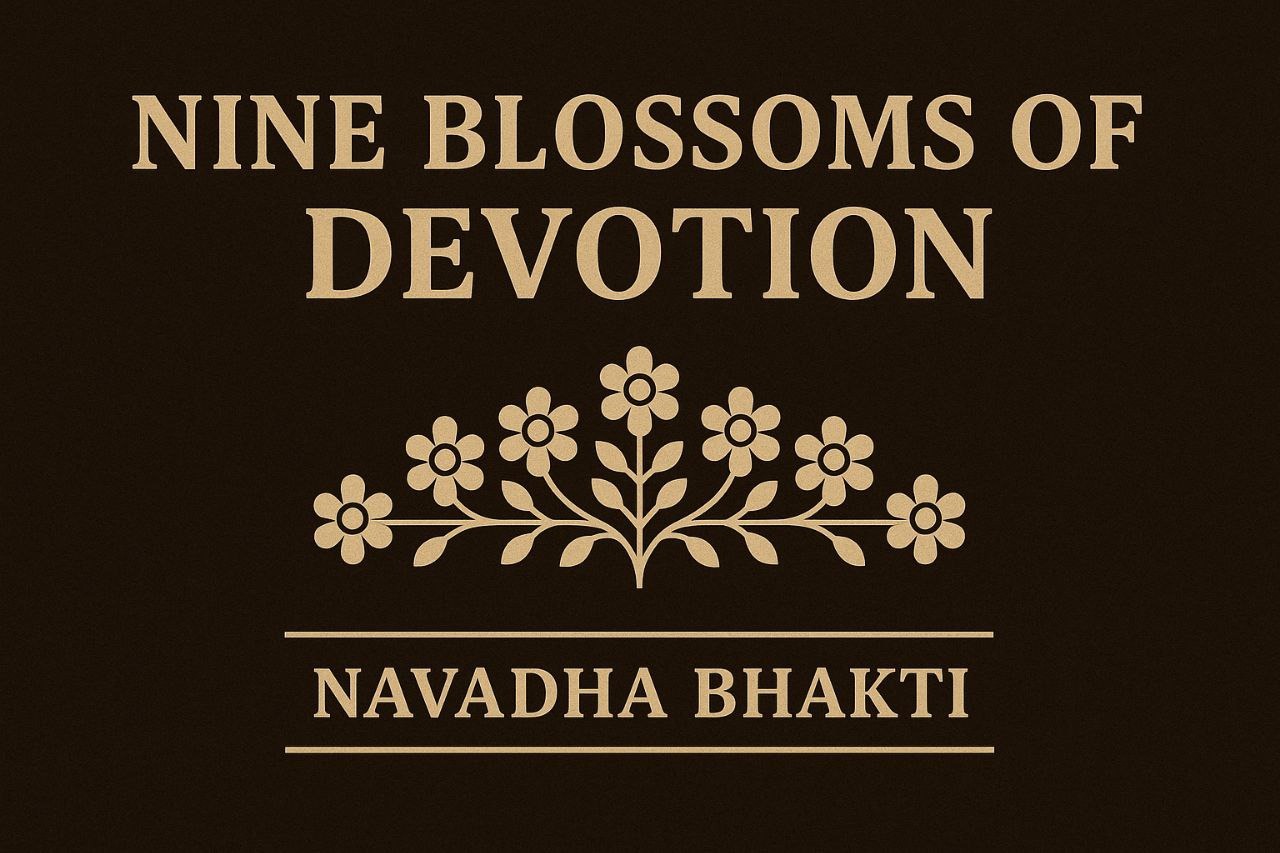🌸 "Nine Blossoms of Devotion: A Journey Through Navadha Bhakti"

In the vast spiritual landscape of Sanātan Dharma, Bhakti or devotion stands as a luminous path that connects the finite with the Infinite. Among the various expressions of Bhakti, the concept of Navadha Bhakti, the Nine Limbs of Devotion, glows like nine sacred lamps illuminating the heart of the seeker.
Rooted in the timeless wisdom of the Śrīmad Bhāgavatam, these nine forms are not mere rituals but living practices that refine the soul and deepen one’s relationship with the Divine.
"True devotion is not bound by form, but blooms in the sincerity of the heart. Bhakti is the fragrance of the soul's yearning for union."
~ Adarsh Singh
🌺 Śravaṇam ~ Listening with the Soul
Śravaṇam means attentive listening to divine names, glories, and Leelas (divine pastimes) of the Lord. It is the first step on the ladder of Bhakti. Listening purifies the heart, silences the ego, and awakens dormant divinity within.
Example: Parīkṣit, the noble king, attained liberation simply by listening to the Bhāgavatam from Śrī Śukadeva.
"When you truly listen, you don't just hear the story, you dissolve into its truth." ~ Adarsh Singh
🌼 Kīrtanam ~ Singing the Name Divine
Kīrtanam is the joyous chanting or singing of the names and glories of the Lord. It is said that the divine name carries the same potency as the Lord Himself.
Example: Countless saints like Namdev, Meera, and Chaitanya Mahaprabhu attained God through Kīrtan.
"When the tongue dances with the divine name, the soul sways in ecstasy." ~ Adarsh Singh
🌸 Smaraṇam ~ Remembrance is Worship
Smaraṇam is constant remembrance of God in mind and heart, remembering His name, form, qualities, and leelas. It transforms the mind into a temple.
Example: Prahlāda meditated upon Lord Nārāyaṇa even amidst severe adversity and torture.
"The one who remembers God in every breath, lives beyond time and death." ~ Adarsh Singh
🌻 Pāda-Sevanam ~ Serving the Lord’s Feet
Pāda-sevanam is symbolic of humility and surrender. It involves physical acts of service like cleaning temples, decorating altars, or serving devotees. Serving God’s feet represents anchoring the mind at the divine source.
Example: Devi Lakshmi serves at the feet of Lord Vishnu as a mark of highest reverence.
"In serving the sacred feet, we walk the path of humility to the heart of the Divine." ~ Adarsh Singh
🪷 Archanam ~ Worship with Love and Ritual
Archanam is ceremonial worship with offerings of flowers, incense, food, and mantras. It sanctifies the material world and makes every act a form of offering.
Example: King Prithu is known for elaborate ritualistic worship and sacrifice for the welfare of the people.
"Every flower you offer with love becomes a whisper of your soul to the Divine." ~ Adarsh Singh
🌹 Vandanam ~ Bowing in Reverence
Vandanam is heartfelt prayer and prostration. It reflects surrender, reverence, and the dissolution of ego. A simple bow becomes a divine act when it is soaked in sincerity.
Example: Akrura, while on his way to meet Krishna, offered silent but deep prayers, his heart overflowed with devotion.
"To bow before the Divine is to rise above the self." ~ Adarsh Singh
🌿 Dāsyam ~ Becoming the Servant of God
Dāsyam means serving God as a loyal servant, with discipline and devotion. It emphasizes action over emotion, offering every karma as a sacred duty.
Example: Hanuman is the eternal embodiment of Dāsyam Bhakti ~ selfless, strong, and surrendered.
"In losing oneself in the Lord’s service, one finds the Self eternal."
~ Adarsh Singh
🌾 Sākhyam ~ Friendship with the Divine
Sākhyam cultivates an intimate relationship with God, where the devotee considers the Lord a close friend. It reflects trust, transparency, and loving companionship.
Example: Arjuna was not just a warrior but Krishna’s closest companion, and the Gītā was born from that sacred friendship.
"When God becomes your friend, life becomes a divine conversation." ~ Adarsh Singh
🌙 Ātma-Nivedanam ~ Complete Surrender
The final and highest limb, Ātma-nivedanam, is the surrender of the ego and the offering of one’s entire being to God ~ mind, body, soul, and life.
Example: Bali Maharaj, even after losing everything, offered himself entirely to Lord Vāmana, and thus gained eternal grace.
"To surrender completely is not to lose yourself, but to merge into the vastness of the Divine." ~ Adarsh Singh
🕉️ One Path, Many Blossoms
These nine limbs of Bhakti are not rigid compartments but living petals of a single lotus, the lotus of the heart that opens in divine love. Whether you choose one, many, or all, the ultimate fruit is the same: union with the Supreme.
You don’t need scholarship or riches to practice Bhakti. You need sincerity, surrender, and silence within.
"In the garden of Bhakti, Navadha are the nine blossoms that bloom only when watered with love, illuminated by faith, and rooted in surrender." ~ Adarsh Singh
Mon Jul 21, 2025
